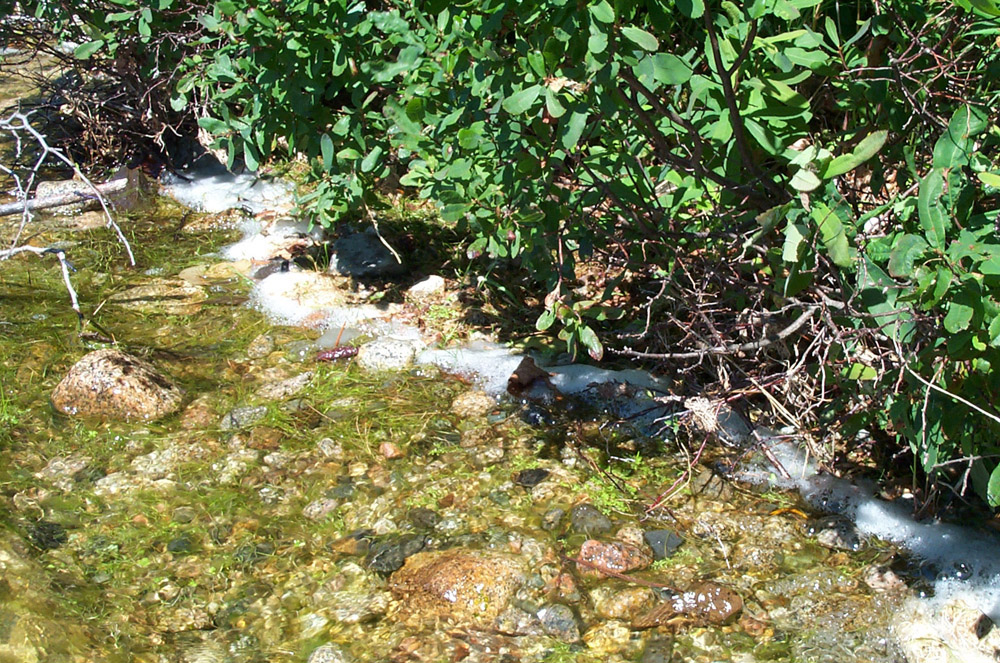What’s that stuff on the surface of the lake? What’s that blob in the water? Why are some lakes blue and others green or brown? In 2005, the Senator George J. Mitchell Center at the University of Maine published A Field Guide to Aquatic Phenomena, a full-color fact sheet and website that explains all the weird and wonderful sights to be seen in lakes, ponds, rivers, and streams.
 The guide was intended to help people learn what was natural, and what was “pollution.” For example, one might assume that an oily sheen is from leaked gasoline or some other petroleum product. Yet naturally occurring bacteria can create silvery rainbow sheens as they break down metals and other elements in groundwater where it seeps out of the ground.
The guide was intended to help people learn what was natural, and what was “pollution.” For example, one might assume that an oily sheen is from leaked gasoline or some other petroleum product. Yet naturally occurring bacteria can create silvery rainbow sheens as they break down metals and other elements in groundwater where it seeps out of the ground.
Now, the Maine Volunteer Lake Monitoring Program has incorporated the information in the guide into a new smartphone application. According to Roberta Hill at the monitoring program, the “Maine Field Guide to Aquatic Phenomena” app will help users identify—and learn about—the remarkable array of natural phenomena that may be encountered on the lakes and ponds of Maine, as well as a number of invasive aquatic species and other threats.
Formed in 1971, Maine’s Volunteer Monitoring Program is the longest-standing statewide citizen effort of its type in the country, as well as one of the largest, with more than 1,200 active volunteers monitoring more than 500 lakes statewide. Trained volunteers gather and share scientific information pertaining to lake health. In addition to being the primary source of lake data in the state, these volunteers play key stewardship and leadership roles in their communities.
The guide features the aquatic “curiosities” such as oily surface sheen and clumps of foam, but also covers a wide variety of flora and fauna, including: plants, algae, fish, amphibians, turtles, insects, shellfish, etc.
Here’s an excerpt from the section on water color.
Ever Wondered Why Some Lakes are Bluer than Others?
“Blue lakes are generally clear, clean lakes. The color of most lakes, however, will vary with the time of day, the weather, the season of the year, and occasionally changes in the amount of dissolved or suspended material in the water. The reason clear lakes are blue and not some other color, has to do with the nature of both light and water. Longer wavelengths of the visible light spectrum (red, orange, yellow, green) are more readily absorbed by water molecules than shorter wavelengths (blue and violet). When water is clear, with less dissolved or suspended material to scatter light, the light can travel deeper into the water. The deeper the light penetrates, the more the longer light waves are absorbed. The remaining blue and violet wavelengths continue to travel into deeper water until they are eventually scattered and reflected upward.
The darker the blue, the deeper the water.
Some of the blue color may also be due to the light from the overhead blue sky striking the surface of the lake and being reflected directly upward.”
Hill said the new mobile app will be available in the Apple and Android stores “by the time the ice is coming off the lakes.”
For more information, visit http://www.mainevlmp.org/
Catherine Schmitt is Communications Director for the Maine Sea Grant College Program at the University of Maine.






